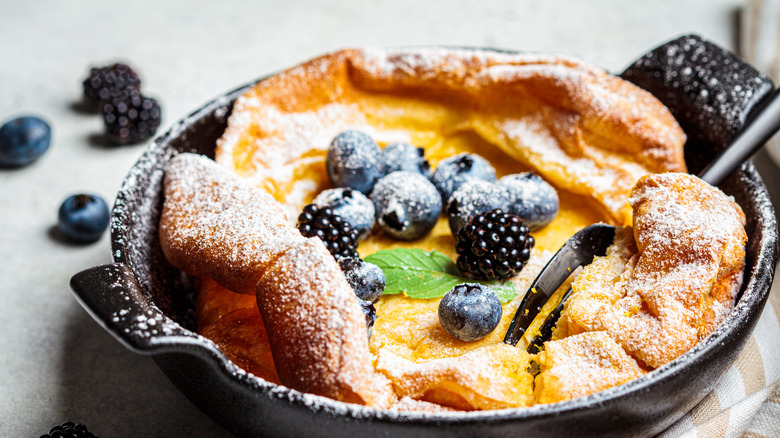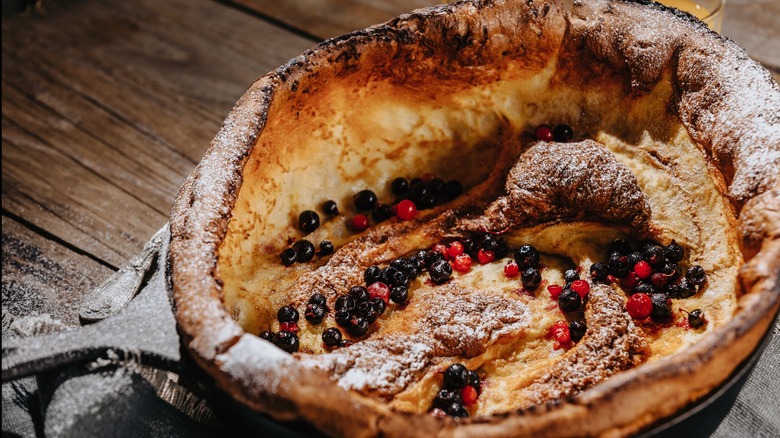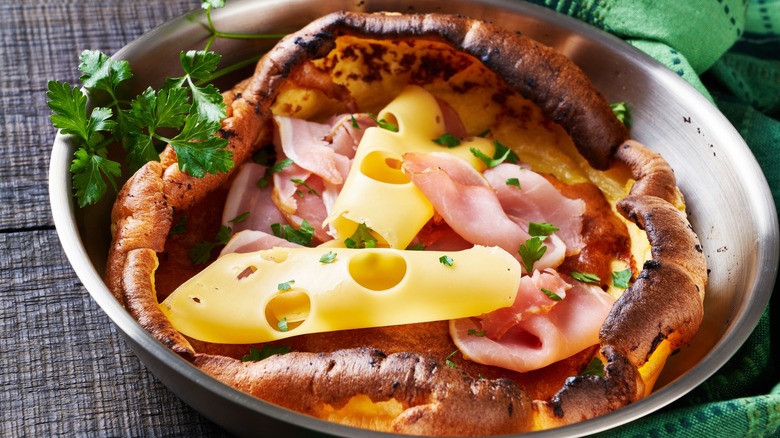How To Make Sure Your Dutch Baby Has Perfectly Crisp Edges
A Dutch baby is the perfect vessel for anything you want for breakfast or any other meal — both sweet and savory work well here. A common issue, though, is making sure the Dutch baby is crispy, puffy, and tender — all at once.
A Dutch baby is part pancake, part crepe, part Yorkshire pudding, and needs to be treated as such, which means focusing on the batter. You need to make sure the dough is not overworked, resulting in a rubbery pancake, or not worked enough, resulting in a flat pancake. Usually, it consists of a thin batter. And, much like one used to make crepes or popovers, it consists mostly of eggs, milk, and flour. However, there is no leavening agent. Instead, most recipes call for using a blender to incorporate as much air as possible. As the Dutch baby cooks, all that puffiness evaporates in the hot oven.
While you can do everything right, sometimes your Dutch baby will come out rather limp and soggy, with lackluster edges. The problem might be your pan.
Your pan needs to be piping hot to ensure crispiness
For a Dutch baby, the pan has to be in the oven while you make the batter. So, as soon as you preheat your oven, your vessel should be in there as well, so it's hot enough to cook the batter pretty much on contact. If your pan is not hot enough, you won't get the perfectly crisp edges and instead, the Dutch baby will come out flat and limp.
Try to let the pan preheat for at least 10 minutes, preferably up to 20. If you know your oven runs cold or hot, adjust accordingly. A laser thermometer is your friend here. When you pour your batter in, it should sizzle and start settling immediately. To avoid painful, greasy splatters, don't over-grease the pan. Then, close the door, put the Dutch baby in, and don't open the oven again until your pastry is golden brown and puffy.
Additionally, make sure you're using an oven-proof vessel that can withstand the heat; some Dutch baby recipes call for 425 degrees Fahrenheit. A cast iron skillet is the ideal vessel for a Dutch baby, as it retains heat very well on all sides. You don't have to use a cast iron pan, but you should choose something that can maintain heat. Metal works well, so a stainless steel skillet is good, but other materials don't conduct heat as quickly as metal. If it doesn't work one way, try another.
Level up your Dutch baby with creative toppings
The great thing about a Dutch baby is that it's versatile. First and foremost, it's great for breakfast. If you're in the mood for a sweet breakfast, you can keep your Dutch baby simple and drizzle it with butter and syrup, or fresh berries and powdered sugar. Any creative waffle or pancake toppings would do well on a Dutch baby. Think of it as a chance to express your creativity through food.
But you're not limited to sweet toppings if you're more of a savory person. Omit the powdered sugar and instead add fresh herbs to complement your toppings. Other toppings like sauteed mixed mushrooms topped with a runny egg are great for breakfast.
While Dutch babies are great for a savory breakfast, they're also ideal for an easy, light supper. Folds of smoked salmon dotted with the Lebanese condiment labneh or crème fraîche and sprinkled with paper-thin red onion work well here. Add in a tart salad of mixed greens and you've got yourself a well-rounded, super flavorful meal.


